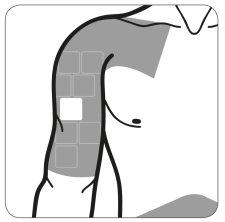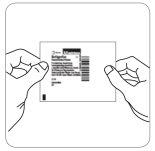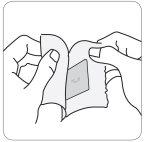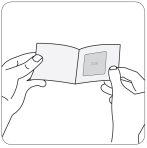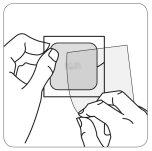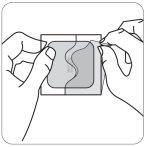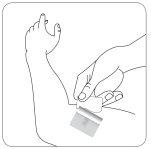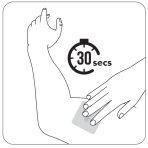
ROTIGOTINE LUYE 2 mg/24h TRANSDERMAL PATCHES
Ask a doctor about a prescription for ROTIGOTINE LUYE 2 mg/24h TRANSDERMAL PATCHES

How to use ROTIGOTINE LUYE 2 mg/24h TRANSDERMAL PATCHES
Introduction
Package Leaflet: Information for the User
Rotigotina Luye 2 mg/24 h Transdermal Patches EFG
Read all of this leaflet carefully before you start using this medicine because it contains important information for you.
- Keep this leaflet, you may need to read it again.
- If you have any further questions, ask your doctor or pharmacist.
- This medicine has been prescribed for you only. Do not pass it on to others. It may harm them, even if their signs of illness are the same as yours.
- If you get any side effects, talk to your doctor or pharmacist. This includes any possible side effects not listed in this leaflet. See section 4.
Contents of the pack
- What is Rotigotina Luye and what is it used for
- What you need to know before you use Rotigotina Luye
- How to use Rotigotina Luye
- Possible side effects
- Storing Rotigotina Luye
- Contents of the pack and other information
1. What is Rotigotina Luye and what is it used for
What is Rotigotina Luye
Rotigotina Luye contains the active substance rotigotine.
It belongs to a group of medicines known as “dopamine agonists”. Dopamine is an important messenger in the brain for movement.
What is Rotigotina Luye used for
Rotigotina Luye is used in adults to treat the signs and symptoms of:
- Parkinson's disease- Rotigotina may be used alone or with another medicine called levodopa.
- Restless Legs Syndrome(RLS) – this syndrome can be associated with discomfort in the legs or arms, a need to move, sleep disturbances and a feeling of tiredness or sleepiness during the day. Treatment with rotigotine reduces or stops the duration of these symptoms.
2. What you need to know before you use Rotigotina Luye
Do not use Rotigotina Luye if:
- you are allergicto rotigotineor any of the other ingredientsof this medicine (listed in section 6)
- you are going to have a magnetic resonance imaging(MRI) scan (diagnostic images of the inside of the body, created using magnetic energy instead of X-ray energy)
- you need a cardioversion(specific treatment for heart rhythm disturbances).
You must remove the rotigotine patch just before having a magnetic resonance imaging (MRI) scan or cardioversion to avoid skin burns because the patch contains aluminum. You can put on a new patch when these tests are over.
Do not use rotigotine if any of the above applies to you. If you are not sure, talk to your doctor or pharmacist first.
Warnings and precautions
Talk to your doctor or pharmacist before you start using rotigotine, as:
- you should have your blood pressurechecked regularly while you are using rotigotine, especially when you start treatment. Rotigotina Luye may affect your blood pressure.
- you should have your eyesightchecked regularly while you are using rotigotine. If you notice any problems with your eyesight between checks, you should tell your doctor immediately.
- if you have serious liver problems, your doctor may need to adjust your dose. If your liver problems get worse while you are using Rotigotina Luye, you should tell your doctor as soon as possible.
- you may have skin reactionscaused by the patch – see ‘Skin problems caused by the patch’ in section 4.
- you may feel very sleepy or fall asleep suddenly– see ‘Driving and using machines’ in section 2.
- you may have involuntary muscle contractions that cause abnormal movements or postures, often repetitive (dystonia), abnormal postures or lateral flexion of the spine (also called pleurosthosis or Pisa syndrome). If this happens, your doctor may decide to adjust your medication
- the symptoms of Restless Legs Syndromemay start earlier than usual, be more intense and involve other parts of the body. If you experience these symptoms before or after starting treatment with rotigotine, contact your doctor as you may need to have your treatment adjusted.
Medicines used to treat Parkinson's disease and Restless Legs Syndrome should be reduced or stopped gradually. Tell your doctor if, after stopping or reducing your treatment with rotigotine, you experience symptoms such as depression, anxiety, fatigue, sweating or pain.
You may lose consciousness
Rotigotina may cause loss of consciousness. This can happen especially when you start treatment with rotigotine or when you increase the dose. Tell your doctor if you lose consciousness or feel dizzy.
Changes in behavior and abnormal thoughts
Rotigotina Luye may cause side effects that change your behavior (how you act). If your family or caregiver, or your doctor, are concerned about changes in your behavior, it may be helpful to tell a family member or caregiver that you are using this medicine and to read the leaflet
This includes:
- a strong desire to take large doses of Rotigotina Luye or other medicines used to treat Parkinson's disease and Restless Legs Syndrome
- anxiety or a strong desire to behave in an unusual way that you cannot control and that may harm you or others – these symptoms are mainly seen in patients with Parkinson's disease
- abnormal thoughts or behaviors – most of these symptoms occur more frequently in patients with Parkinson's disease.
For more information, see ‘Changes in behavior and abnormal thoughts’ in section 4.
Children and adolescents
This medicine must notbe given to childrenunder 18 years because its safety and efficacy in this age group are not known.
Other medicines and Rotigotina Luye
Tell your doctor or pharmacist if you are using, have recently used or might use any other medicines. This includes medicines without a prescription and herbal medicines.
If you are being treated with rotigotine and levodopa at the same time, some side effects may get worse. This includes seeing or hearing things that are not real (hallucinations), uncontrolled movements related to Parkinson's disease (dyskinesia), swelling in the legs and feet.
Do not take the following medicines while you are using rotigotine - as they may reduce its effect:
- ‘antipsychotic’ medicines - used to treat certain mental illnesses
- metoclopramide - used to treat nausea and vomiting.
Talk to your doctor before using rotigotine if you are taking:
- sedative medicines such as benzodiazepines or medicines used to treat mental disorders or depression
- medicines that lower blood pressure. Rotigotina may lower blood pressure when standing up - this effect could get worse when taking medicines to lower blood pressure.
Your doctor will tell you if it is safe to take these medicines while you are using rotigotine.
Using Rotigotina Luye with food, drinks and alcohol
Since rotigotine enters the bloodstream through the skin, taking food or drinks does not affect how this medicine is absorbed. You should talk to your doctor if you can drink alcohol while using rotigotine.
Pregnancy and breast-feeding
Do not use rotigotine if you are pregnant. This is because the effects of rotigotine on pregnancy and on the fetus are not known.
Do not breast-feed during treatment with rotigotine. This is because rotigotine may pass into breast milk and affect your baby. It is also likely to reduce the amount of milk produced.
If you are pregnant or breast-feeding, think you may be pregnant or are planning to have a baby, ask your doctor or pharmacist for advice before using this medicine.
Driving and using machines
Rotigotina may make you feel very sleepy or fall asleep suddenly. If this happens, do not drive. In rare cases, some people have fallen asleep while driving, which has led to accidents.
Also, do not use tools or machines if you feel very sleepy - or perform any activity in which you may put yourself or others at risk of serious injury.
3. How to use Rotigotina Luye
Follow the instructions for administration of this medicine exactly as told by your doctor or pharmacist. If you are not sure, ask your doctor or pharmacist.
Which patch dose to use
The dose of rotigotine you need depends on your illness - see below.
Rotigotina is available in patches of different doses that release the medicine over 24 hours. The doses are 1 mg/24 h, 2 mg/24 h, 3 mg/24 h, 4 mg/24 h, 6 mg/24 h and 8 mg/24 h. The 1 mg/24 h and 3 mg/24 h patches are used to treat Restless Legs Syndrome, while the 4 mg/24 h, 6 mg/24 h and 8 mg/24 h patches are used to treat Parkinson's disease. The 2 mg/24 h patches are used to treat both Parkinson's disease and Restless Legs Syndrome.
- You may need to use more than one patch to reach the dose prescribed by your doctor.
- For doses above 8 mg/24 h (doses prescribed by your doctor above the available doses), several patches must be used to reach the final dose. For example, a daily dose of 10 mg can be achieved using a 6 mg/24 h patch and a 4 mg/24 h patch.
- Patches cannot be cut into pieces.
Treatment of Parkinson's disease
Patients who are not taking levodopa – early stages of Parkinson's disease
- Your starting dose will be one 2 mg/24 h patch per day.
- From the second week onwards, your daily dose will be increased by 2 mg every week until you reach the right maintenance dose for you.
- For most patients, the right dose is between 6 mg and 8 mg per day. This is usually reached between 3 and 4 weeks.
- The maximum dose is 8 mg per day.
Patients who are taking levodopa - advanced stages of Parkinson's disease
- Your starting dose will be one 4 mg/24 h patch per day.
- From the second week onwards, your daily dose will be increased by 2 mg every week - until you reach the right maintenance dose for you.
- For most patients, the right dose is between 8 mg and 16 mg per day. This is usually reached between 3 and 7 weeks.
- The maximum dose is 16 mg per day.
Treatment of Restless Legs Syndrome
- Your starting dose will be one 1 mg/24 h patch per day.
- From the second week onwards, your daily dose will be increased by 1 mg every week - until you reach the right maintenance dose for you. This is when you and your doctor confirm that your symptoms are adequately controlled and that the side effects of the medicine are acceptable.
- The maximum dose is 3 mg per day.
If you have to stop taking this medicine, see “If you stop using Rotigotina Luye” in section 3.
How to use the rotigotine patches
Rotigotina Luye is a patch that you apply to your skin.
- Check that you have removed the used patch before putting on a new one.
- Put the new patch on a different area of skin each day.
- Leave the patch on your skin for 24 hours, then remove it and put on a new one.
- Change the patchat about the same time every day.
?
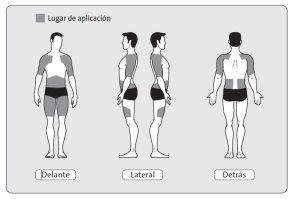
Where to put the patch
Put the sticky side of the patch on clean, dry and healthy skin in the following areas, as indicated in the grey areas of the drawing:
| |
To avoid skin irritation
|
|
If you continue to have skin problems caused by the patch, see “Skin problems caused by the patch” in section 4 for more information.
To prevent the patch from coming loose or falling off
- Do notput the patch on an area where it may be rubbed by tight clothing.
- Do notuse creams, oils, lotions, powdersor any other skin productswhere you are going to put the patch. Nor on top of or near another patch that you are already using.
- If you need to put a patch on an area of skin where you have hair, you should shave(remove hair from) the area of skin at least 3 days beforeyou put the patch on that site.
- If the edges of the patch come loose, you can hold the patch in place with a band-aid.
If the patch falls off, you should put a new one on for the rest of the day and the next day, put a new patch on at the usual time.
- You should avoidheatingthe patch area – for example, too much sunlight, saunas, hot baths, hot compresses or hot water bottles. This is because the medicine could be released more quickly. If you think you have overheated, contact your doctor or pharmacist.
- Always check that the patch has not fallen off after activities such as bathing, showering or exercising.
- If the patch has irritated your skin, you should keepthe irritated area protected from direct sunlight. This is because sun exposure could cause changes in skin color.
How to use the patch
- Each patch is packaged individually in a pouch.
- Before you open the pouch, you should decide where you are going to put the new patch and check that you have removed the used patch.
- When you have opened the pouch and removed the disposable layer from the patch, you should put the patch on your skin immediately.
1. | To open the pouch, hold both sides of the pouch with both hands. |
|
2. | Peel off the layers. |
|
3. | Open the pouch. |
|
4. | Remove the patch from the pouch. Remove the colored disposable layer from the top, and discard it. A separable protective layer covers the adhesive side of the patch. |
|
5. | Hold the patch with both hands with the transparent layer facing you. Remove the layer from one side. Do not touch the adhesive surface of the patch with your fingers. |
|
6. | Put the adhesive surface of the patch on your skin and remove the rest of the protective layer. |
|
7. | Press the patch firmly with the palm of your hand. Keep pressing the patch for about 30 seconds. This ensures that the patch is in contact with your skin and the edges are well stuck. Wash your hands with water and soap immediately after handling the patch. |
|
How to remove the used patch
- Remove the used patch slowly and carefully.
- Gently wash the area with warm water and a mild soap. This will remove any remaining adhesive from your skin. You can also use a little baby oil to remove any remaining adhesive.
- Do not use alcohol or other liquid solvents - such as nail varnish remover. This could irritate your skin.
If you use more Rotigotine Luye than you should
Using higher doses of Rotigotine Luye than your doctor has prescribed may cause side effects such as nausea or vomiting, decreased blood pressure, seeing or hearing things that are not real (hallucinations), confusion, extreme drowsiness, involuntary movements, and convulsions.
In these cases, inform your doctor or go to the hospital as soon as possible. They will indicate what you should do.
In case of overdose or accidental ingestion, consult your doctor or pharmacist immediately or call the Toxicology Information Service, phone 91 562 04 20, indicating the medication and the amount ingested.
If you forgot to change the patch at your usual time
- If you have forgotten to change the patch at your usual time, change it as soon as you remember. Remove the used patch and apply a new one.
- If you have forgotten to apply a new patch after removing the used patch, apply the new one as soon as you remember.
In both cases, the next day, apply a new one at the usual time. Do not use a double dose to make up for the missed doses.
If you stop treatment with Rotigotina Luye
Do not stop using Rotigotina Luye without consulting your doctor first. Sudden interruption could cause a condition called 'neuroleptic malignant syndrome' that can put your life at risk. The signs include: loss of muscle movement (akinesia), muscle stiffness, fever, unstable blood pressure, increased heart rate (tachycardia), confusion, decreased consciousness (e.g., coma).
If your doctor indicates that you should stop treatment with Rotigotina Luye, the daily doseof Rotigotina Luye should be gradually reduced:
- Parkinson's disease– it should be reduced by 2 mg every two days.
- Restless Legs Syndrome– it should be reduced by 1 mg every two days.
If you have any other doubts about the use of this medication, ask your doctor or pharmacist.
4. Possible side effects
Like all medications, this medication can cause side effects, although not all people suffer from them. Inform your doctor, pharmacist, or nurse if you notice any side effect.
Most likely side effects at the start of treatment
You may experience nauseaand vomiting at the start of treatment. These effects are usually mild or moderate and last for a short time. You should consult your doctorif the effects last for a long time or if they worry you.
Skin problems caused by the patch
- Redness and itching may appear in the skin area where the patch has been applied – these reactions are usually mild or moderate.
- These reactions usually disappear a few hours after removing the patch.
- Consult your doctorif you have a skin reaction that lasts for more than a few days, if it is severe, or if it spreads beyond the area covered by the patch.
- Avoid exposure to the sun and sunlamps in skin areas that show any type of reaction caused by the patch.
- To help prevent skin reactions, the patch should be placed in a different location each day, and the same area should only be used again after 14 days.
You may experience loss of consciousness
Rotigotina Luye may cause loss of consciousness. This can happen especially when starting treatment with Rotigotina Luye or when increasing the dose. Inform your doctor if you lose consciousness or feel dizzy.
Changes in behavior and abnormal thoughts
Inform your doctor if you notice any change in behavior, thought, or both, as indicated below. Your doctor will indicate how to manage or reduce the symptoms.
If your family or caregiver, or your doctor, are concerned about changes in your behavior, it may be helpful to tell a family member or caregiver that you are using this medication and to read the prospectus. Rotigotina Luye may cause anxiety or an overwhelming need to behave in an unusual way and be unable to control the impulse, attack, or temptation to perform certain actions that may harm you or others – these symptoms are mainly observed in patients with Parkinson's disease.
These actions may include:
- strong addiction to gambling – even seriously affecting you or your family
- altered or increased sexual interest and behavior that causes great concern for you and others - for example, increased sexual desire
- uncontrolled shopping or excessive spending
- episodes of binge eating (eating large amounts of food in a short period) or compulsive eating (eating more food than normal or more than needed to satisfy appetite)
Rotigotina Luye may cause other abnormal behaviors and thoughts, which may include:
- abnormal thoughts about reality
- delusional ideas and hallucinations (seeing or hearing things that are not real)
- confusion
- disorientation
- aggressive behavior
- agitation
- delirium
Inform your doctor if you notice any change in your behavior, thought, or both, as indicated above.
Your doctor will indicate how to manage or reduce the symptoms.
Allergic reactions
Inform your doctor if you notice signs of an allergic reaction – which may include swelling of the face, tongue, or lips.
Side effects if you use Rotigotina Luye for Parkinson's disease
Inform your doctor, pharmacist, or nurse if you experience any of the following side effects:
Very common: may affect more than 1 in 10 patients
- headache
- drowsiness or dizziness
- nausea, vomiting
- skin irritation at the patch application site, such as redness and itching
Common: may affect up to 1 in 10 patients
- falls
- hiccups
- weight loss
- swelling in the legs and feet
- feeling of weakness (fatigue), feeling of tiredness
- increased heart rate (palpitations)
- constipation, dry mouth, heartburn
- redness, increased sweating, itching
- vertigo (feeling of spinning)
- seeing or hearing things that are not real (hallucinations)
- low blood pressure when standing up, high blood pressure
- difficulty staying asleep, sleep disorders, difficulty sleeping, nightmares, unusual dreams
- involuntary movements related to Parkinson's disease (dyskinesia)
- loss of consciousness, feeling of dizziness when standing up due to low blood pressure
- inability to control the impulse to perform a harmful action, including addiction to gambling, repetitive actions without sense, compulsive shopping or excessive spending
- episodes of binge eating (eating large amounts of food in a short period), compulsive eating (eating more food than normal or more than needed to satisfy appetite)
Uncommon: may affect up to 1 in 100 patients
- blurred vision
- weight gain
- allergic reaction
- decreased blood pressure
- increased heart rate
- increased sexual desire
- abnormal heart rhythm
- stomach discomfort and pain
- generalized itching, skin irritation
- sudden sleepiness without warning
- inability to achieve or maintain an erection
- feeling agitated, disoriented, confused, or paranoid
- abnormal liver test results or elevated
- visual disturbances such as seeing colors or lights
- increased levels of creatine phosphokinase (CPK) (CPK is an enzyme found mainly in skeletal muscles)
Rare: may affect up to 1 in 1,000 patients
- delusional ideas
- delirium
- feeling of irritability
- aggressive behavior
- psychotic disorders
- rash on large areas of the body
- involuntary muscle spasms (convulsions)
Not known: the frequency is not known
- anxiety about taking high doses of medications like Rotigotina Luye – more than necessary for the treatment of the disease. This is known as 'dopaminergic dysregulation syndrome' and may lead to excessive use of Rotigotina Luye
- diarrhea
- dropped head syndrome
- rhabdomyolysis (a rare, severe muscle disorder that causes pain, sensitivity, and weakness of the muscles and can cause kidney problems)
Inform your doctor, pharmacist, or nurse if you experience any of these side effects.
Side effects if you use Rotigotina Luye for Restless Legs Syndrome
Inform your doctor or pharmacist if you experience any of the following side effects:
Very common: may affect more than 1 in 10 patients
- headache
- nausea
- feeling of weakness (fatigue)
- skin irritation at the patch application site, such as redness and itching
Common: may affect up to 1 in 10 patients
- itching
- feeling of irritability
- allergic reaction
- increased sexual desire
- increased blood pressure
- vomiting, heartburn
- swelling in the legs and feet
- drowsiness, sudden sleepiness without warning, difficulty sleeping, sleep problems, unusual dreams
- inability to control the impulse to perform a harmful action, including addiction to gambling, repetitive actions without sense, compulsive shopping or excessive spending
- episodes of binge eating (eating large amounts of food in a short period), compulsive eating (eating more food than normal or more than needed to satisfy appetite)
Uncommon: may affect up to 1 in 100 patients
- feeling agitated
- feeling of dizziness when standing up due to low blood pressure
Rare: may affect up to 1 in 1,000 patients
- aggressive behavior
- disorientation
Not known: the frequency is not known
- anxiety about taking high doses of medications like Rotigotina Luye – more than necessary for the treatment of the disease. This is known as 'dopaminergic dysregulation syndrome' and may lead to excessive use of Rotigotina Luye
- seeing or hearing things that are not real (hallucinations)
- nightmares
- paranoia
- confusion
- psychotic disorders
- delusional ideas
- delirium
- dizziness
- loss of consciousness, involuntary movements (dyskinesia)
- involuntary muscle spasms (convulsions)
- blurred vision
- visual disturbances such as seeing colors or lights
- vertigo (feeling of spinning)
- increased heart rate (palpitations)
- abnormal heart rhythm
- low blood pressure
- hiccups
- constipation, dry mouth
- stomach discomfort and pain
- diarrhea
- redness, increased sweating
- generalized itching, skin irritation
- generalized rash
- inability to achieve or maintain an erection
- weight loss, weight gain
- abnormal liver test results or elevated
- increased heart rate
- increased levels of creatine phosphokinase (CPK) (CPK is an enzyme found mainly in skeletal muscles)
- falls
- rhabdomyolysis (a rare, severe muscle disorder that causes pain, sensitivity, and weakness of the muscles and can cause kidney problems)
Inform your doctor or pharmacist if you experience any of these side effects.
Reporting side effects
If you experience any type of side effect, consult your doctor, pharmacist, or nurse, even if it is a possible side effect that does not appear in this prospectus. You can also report them directly through the Spanish Pharmacovigilance System for Human Use Medicines: www.notificaRAM.es. By reporting side effects, you can contribute to providing more information on the safety of this medication.
5. Storage of Rotigotina Luye
Keep this medication out of sight and reach of children.
Do not use this medication after the expiration date shown on the label and carton.
This medication does not require special storage conditions
What to do with used and unused patches
- Used patches still contain the active ingredient, 'rotigotine', which can be hazardous to others. Fold the used patch with the adhesive side facing inward. Place the patch in the original envelope and then throw it away in a safe place, out of the reach of children.
- Medications should not be thrown away in drains or trash. Deposit the packaging and medications you no longer need in the Sigre point. Ask your pharmacist how to dispose of the packaging and medications you no longer need. This will help protect the environment.
6. Package contents and information
The active ingredient is rotigotine.
One patch releases 2 mg of rotigotine every 24 hours. Each 9.2 cm2 patch contains 3.68 mg of rotigotine.
The other components are:
- Supporting layer: pigmented polyethylene, aluminum vapor-coated polyester, orange printing ink
- Matrix layer containing the active ingredient: tocopherol, paraffin, povidone K90, silicone adhesive
- Release layer: fluorosilicone-coated polyester film
- Covering layer: fluorosilicone-coated polyester film
Product appearance and package contents
Rotigotina Luye is a transdermal patch. It is thin, rectangular in shape with rounded corners. The outer part is brown in color and bears the inscription “Rotigotine 2 mg/24 h”.
Rotigotina Luye is available in the following formats:
Packages containing 7, 14, 28, 30, or 84 (multiple package containing 3 packages of 28) patches, each patch is included in an individual envelope.
Only some package sizes may be marketed.
Marketing authorization holder
Luye Pharma AG
Am Windfeld 35
83714 Miesbach
Germany
Manufacturer
Luye Pharma AG
Am Windfeld 35
83714 Miesbach
Germany
Date of last revision of this prospectus: 01/2024
Other sources of information
Detailed information about this medication is available on the website of the Spanish Agency for Medicines and Health Products (AEMPS) (http://www.aemps.gob.es/).
- Country of registration
- Active substance
- Prescription requiredYes
- Manufacturer
- This information is for reference only and does not constitute medical advice. Always consult a licensed doctor before taking any medication. Oladoctor is not responsible for medical decisions based on this content.
- Alternatives to ROTIGOTINE LUYE 2 mg/24h TRANSDERMAL PATCHESDosage form: TRANSDERMAL PATCH, 1 mg/24 hActive substance: rotigotineManufacturer: Exeltis Healthcare S.L.Prescription requiredDosage form: TRANSDERMAL PATCH, 2 mg/24 hActive substance: rotigotineManufacturer: Exeltis Healthcare S.L.Prescription requiredDosage form: TRANSDERMAL PATCH, 3 mg/24 hActive substance: rotigotineManufacturer: Exeltis Healthcare S.L.Prescription required
Online doctors for ROTIGOTINE LUYE 2 mg/24h TRANSDERMAL PATCHES
Discuss dosage, side effects, interactions, contraindications, and prescription renewal for ROTIGOTINE LUYE 2 mg/24h TRANSDERMAL PATCHES – subject to medical assessment and local rules.




